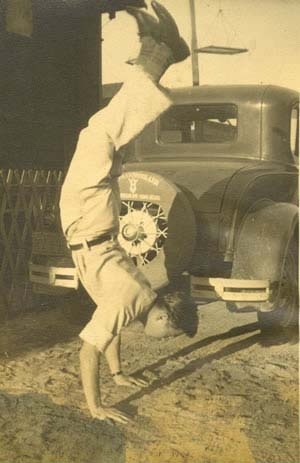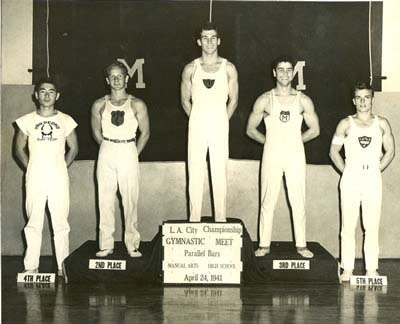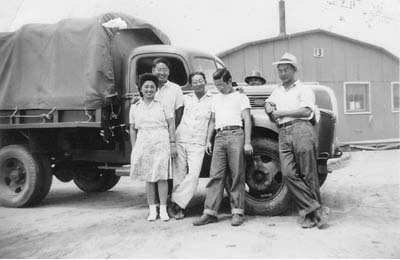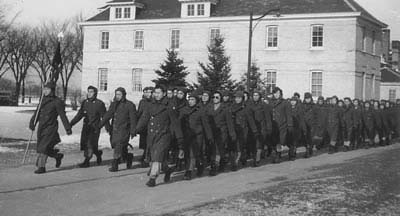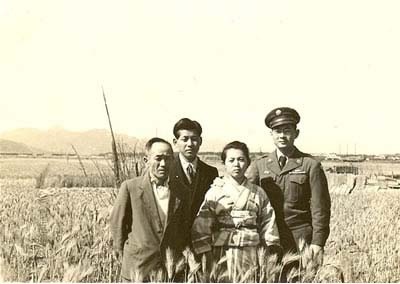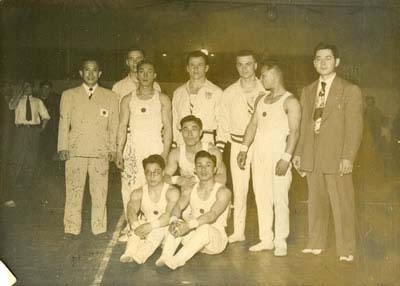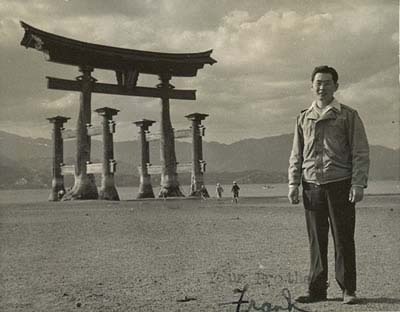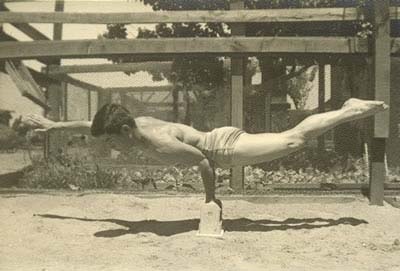My name is Frank Endo, age 81, and I reside in Gardena, California.
I was born in Wilmington, California, on April 20, 1923. I had a twin brother named James. My father owned a fishing boat and my mother worked in the fish cannery. We moved to Terminal Island, California, located several miles from where I was born, in 1935, as the major fishing industry was located there. My parents came from the Shizuoka Prefecture, Japan, and had very little education. My father spoke some English as he had contact with other Americans in the fishing industry. However, my mother spoke no English. My parents could not help me to read, write, or speak the English language. This was the case for most of the Nisei. I was brought up during the depression and went hungry in the 1930s. I had my lunch bag stolen several times during the time I attended grammar school. There were over 3000 Issei and Nisei living on Terminal Island. It was Little Japan! Every Sunday, I attended the Terminal Island Buddhist Church, but I became a Christian at age 13. I attended San Pedro Jr. High School by crossing the L.A. Harbor Channel every day.
While in 8th grade, I attended an Open House at the San Pedro High School gymnasium. There were gymnasts working out. I noticed a gymnast executing a beautiful handstand on the parallel bars. I had never seen this before and it impressed me so much that I vowed to work on that same handstand every day during my regular gym class in junior high school so that by the time I got to high school, I would be able to perform that same skill. This decision was the turning point of my life toward gymnastics.
Finally, in 1940, I began attending San Pedro High School, which was located on the hilltop adjacent to Dana Junior High School I had attended. I immediately made a point to sign up for gymnastics as a 10th grader. It appeared that it would be difficult to get into gymnastics as it was so popular and the class was already full. So, I told the coach that I loved gymnastics and I had been working on the handstand. He reluctantly accepted me in the class. I WAS THRILLED! The handstand that I worked on for one year was just as good as anyone in the gym.
Then, I started to workout and familiarize myself on the various apparatus, as the gymnastic competition would begin shortly. I was given my uniform and began competing on the floor exercises and the parallel bars. After a couple of competitions, placing 2nd and 3rd, I finally won both events on my third time out. That season, I finished 4th on my school team for the most points earned. It was great learning experience.
I observed and self-taught myself by watching those who were better and I picked up new skills from them. I wanted to excel in this sport. My coach knew football, but not gymnastics. The following season, I added two additional events—the pommel horse and the horizontal bar. From the beginning, I took first on the floor exercise and the parallel bars and 2nd and 3rd on the two new events. I was the high point man at every competition. At the league finals, consisting of six high schools, I won the floor exercise and parallel bars. I went on to the Los Angeles County City Finals consisting of forty high schools placing in both my favorite events—the floor exercise and parallel bars.
Then, on December 7, 1941, I crossed the Los Angeles Harbor to see a movie. Upon arriving in San Pedro, I was detained and held there by Military Police.
Then, World War II came along and I was unable to finish school. I had one year to graduate. I could not compete any longer. I was sent to the Santa Anita Assembly Center on April 24, 1942 for several months and then to Amache Relocation Center where 7600 of us were incarcerated. The name Amache was the daughter of the chief of the Cheyenne Indian tribe that once frequented this area. She married an early pioneer builder and cattleman, John Prowers. The county of Prowers was named after him.
I taught gymnastics at Amache. While being incarcerated at Amache, the U.S. Government came into our center asking the young men to volunteer into the U.S. Army. Friends of mine said they would join. So, I went and asked my mother, “I want to volunteer for the U.S. Army and fight for America.” Her answer was “Bakatare, shinde shimau yo—shuyojo kara shigan suru kot wa nai.” (Translation: “No way, you’ll get killed—you don’t volunteer while being incarcerated.”) After two years and three months in Amache, I relocated to Chicago with my mother and brother.
I immediately joined the Hyde Park YMCA in South Chicago and won the 1945 Jr. All-Around Gymnastics Championships at the University of Chicago. That same year, I competed in weightlifting. I did a great deal of lifting on Terminal Island as a young man. I took second in Chicago City and second in the Illinois State Championships.
While in Chicago, I was baptized by the Reverend Jitsuo Morikawa who was my minister on Terminal Island.
Then, on February 2, 1945, I reported for induction into the U.S. Army and went to Camp Gordon, Georgia, for my basic training.
After basic training, I was transferred to Ft. Snelling Military Language School in Minnesota to study the Japanese military terminology and language.
Upon completion, the war in Japan had just ended. I was shipped by military transport to Japan. I arrived in Yokohama Harbor and could see Mt. Fuji on a clear beautiful morning. I knew that I was in Japan! I was transported to Ft. Repo Depot in Tokyo. There, I saw many hungry Japanese for the first time. I helped in the Army kitchen and was able to sneak out the left-overs and fed the Japanese for several days.
My father, being the oldest son of five boys, returned to Japan in 1941 to operate my grandfather’s business. He resided in Shizuoka. Shizuoka was located some 100 miles southwest of Tokyo. I made a point to see him and spent one night with him. The U.S. Army did not have a bed to check that night, so I was not caught going AWOL.
I was then sent to the Tokyo NYK building where all of the interpreters and translators were assembled before being assigned to a unit. Since I was in the upper class at Ft. Snelling, I was assigned to the Osaka Branch Office for the war crimes investigation. We interviewed Japanese Army personnel that handled American airmen that crash landed in the South Pacific or in Japan. We had to find out how our American airmen were treated. If they had been mistreated or killed, we had to locate the bodies if there were still missing. The Japanese noticed my gymnastics skill while I was working out one day at the Osaka YMCA. The director of the Osaka YMCA invited me to their first National Sports Festival. I met Mr. Takahashi Kondo, President of the Japan Gymnastics Association at that festival, who resided in Tokyo.
I was discharged in November 1947 and remained in Osaka as interpreter/chief clerk as a Department of Army Civilian (DAC).
In 1948, I was transferred back to Tokyo headquarters. I was invited by Mr. Kondo to their National Gymnastics Championships. Many invitations to their gymnastics competitions followed. I noted several of their gymnastics equipment were old fashion and needed upgrading. Japan had been fighting China since 1936 followed by World War II. The Japanese needed help and I just happened to be there to give them the information.
From 1949 through 1950, I remained in Tokyo working for the U.S. Air Force Intelligence making targets in North Korea and in Russia. I interviewed a Japanese prisoner that had returned from Russia. He stated that he had worked in and around a chemical plant north of the Yalu River in North Korea. An Air Force Colonel came to my office and asked if the information was reliable. I stated that I felt the information was very reliable. General MacArthur bombed that target. I learned later that President Truman did not want any bombing north of the Yalu River. For this, General MacArthur was fired and returned back to the United States. This was top secret for decades and I did not even mention this to my immediate family.
Then, in early 1950, at the request of the Japan Gymnastics Association, I invited the USA men’s Olympic gymnastics team to Japan for their first home international competition. I was asked to foot the bill. However, the Asahi Press came up with the currency to sponsor the trip. This opened the door for Japan to enter into the international competition and the Olympic Games. During the USA team visit to Japan, I made a special request for the USA team along with Mr. Kondo to visit General Douglas MacArthur at his Tokyo Headquarters. I introduced the team and coach to the General and spent 27 minutes in his office on May 26, 1950. The General stated that he was the USA Delegation Chief at the 1924 Olympic Games in Amsterdam. Mr. Roy Moore, the coach of the USA team, was a gymnast at that Olympic and so they had some conversation about that game. My oldest son is Douglas, named after the general.
During my stay in Japan, I took advantage of every weekend. In Osaka, I traveled by jeep to Kobe, Kyoto and Nara. I even went as far to Hiroshima to observe the devastation of the atomic blast. There was a great deal of Japanese history to learn and observe. And, every few months I took an overnight military train ride to Shizuoka, some 400 miles northeast of Osaka, to visit my father, sisters and brother. When I was transferred to Tokyo, I purchased an automobile from another American civilian, like myself, who was returning back from the States. There was Yokohama, Nikko, Hakone, etc. Shizuoka was only 100 miles southwest of Tokyo. So, I was able to purchase things from the Army post exchange and bring them to my relatives. While in Japan, I fell in love with a Japanese girl who was working for the American schools in Osaka. Since the peace treaty had not been signed, I wrote to Mr. Mike Masaoka, our Japanese American representative in Washington. He contacted Congressman Sidney R. Yates in Chicago who introduced a Private Bill in Congress. The bill enabled me to marry and bring my wife to America. Mr. Kondo, President of the Japan Gymnastics Association was my best man.
My wife and I returned to California in 1950 and took a coast to coast honeymoon tour by car. While in Chicago, we visited Congressman Sidney R. Yates, who introduced the Private Bill in Congress, to thank him. In New York, we stayed with Mr. Roy E. Moore, the American gymnastic coach that I invited to Japan with the Olympic Gymnasts. Then, I attended college in Los Angeles for the next two years on the G.I. Bill.
I joined the Southern California Gymnastics Judges Association (SCGJA) and started judging gymnastics. I was the first Asian gymnastic judge in America.
In 1959, while judging at the U.S. National Collegiate Gymnastics Championships in Berkeley, California, I was approached by Mr. George Nissen, the President of Nissen Trampoline Company and the inventor of the trampoline, to see if I could arrange a tour of Japan to introduce trampolining. I contacted Mr. Kondo, and we went to Japan and put on 14 exhibitions. It is now an Olympic sport.
The Japanese men gymnasts utilized the trampolining technique to the artistic gymnastics. And, in 1960, the Japanese men won their first Olympic gymnastics in Rome and dominated the sports for the next five Olympics and five World Gymnastics Championships, back to back. I was there and observed the competitions with Mr. Kondo.
After that, many Japanese high school, college and their Olympic gymnastic teams started to come to America. I was their guide, interpreter and judge. In 1972, the U.S. Gymnastics Federation asked me to serve as Head Judge at their U.S. National Gymnastics Championships in Statesboro, Georgia. I have judged many USA National Championships throughout the country. But, the most exciting competition was during the1984 Los Angeles Olympic Games.
In 1990, I was invited to Japan, with my wife, on an all expenses paid trip and presented with the Korosho (the Japanese Hall of Fame).
In 1995, the World Gymnastics Championships was held in Sabae, Japan. I was USA gymnastics tour guide for thirty Americans.
In the year 2000, I had served fifty years as a National and International gymnastics judge in America. The Southern California Gymnastics Judges Association (SCGJA) honored me with the first Frank Endo SCGJA Award. It is awarded annually to the best gymnastic judge in Southern California. I am still active judging gymnastics.
In 2001, the U.S. Gymnastics presented me with the Lifetime Achievement award into the USA Gymnastics Hall of Fame in Philadelphia. Also, I have been serving as one of the directors for the International Gymnastics Hall of Fame (IGHOF) located in Oklahoma City. It has been my pleasure to have nominated and inducted five of Japan’s greatest Olympic Gold Medalists into the IGHOP thus far.
Since 1958, I have been operating a gymnastic supply business in Gardena, California. My two sons, both were gymnasts at California State University in Long Beach and are working with me.
Because of my language training at Ft. Snelling, I hope that I have made a small contribution to rebuilding the country of Japan in the sport of gymnastics after World War II.
* This article was originally contributed to an essay contest about the experiences of the men who served in the Military Intelligence Service during and immediately after World War II. The original title of this essay was "MIS In the Occupation of Japan." Mr. Endo passed away in 2005. For more, you can see Frank Endo's pictures from Amache in the Nikkei Album.
© 2008 Frank Endo



